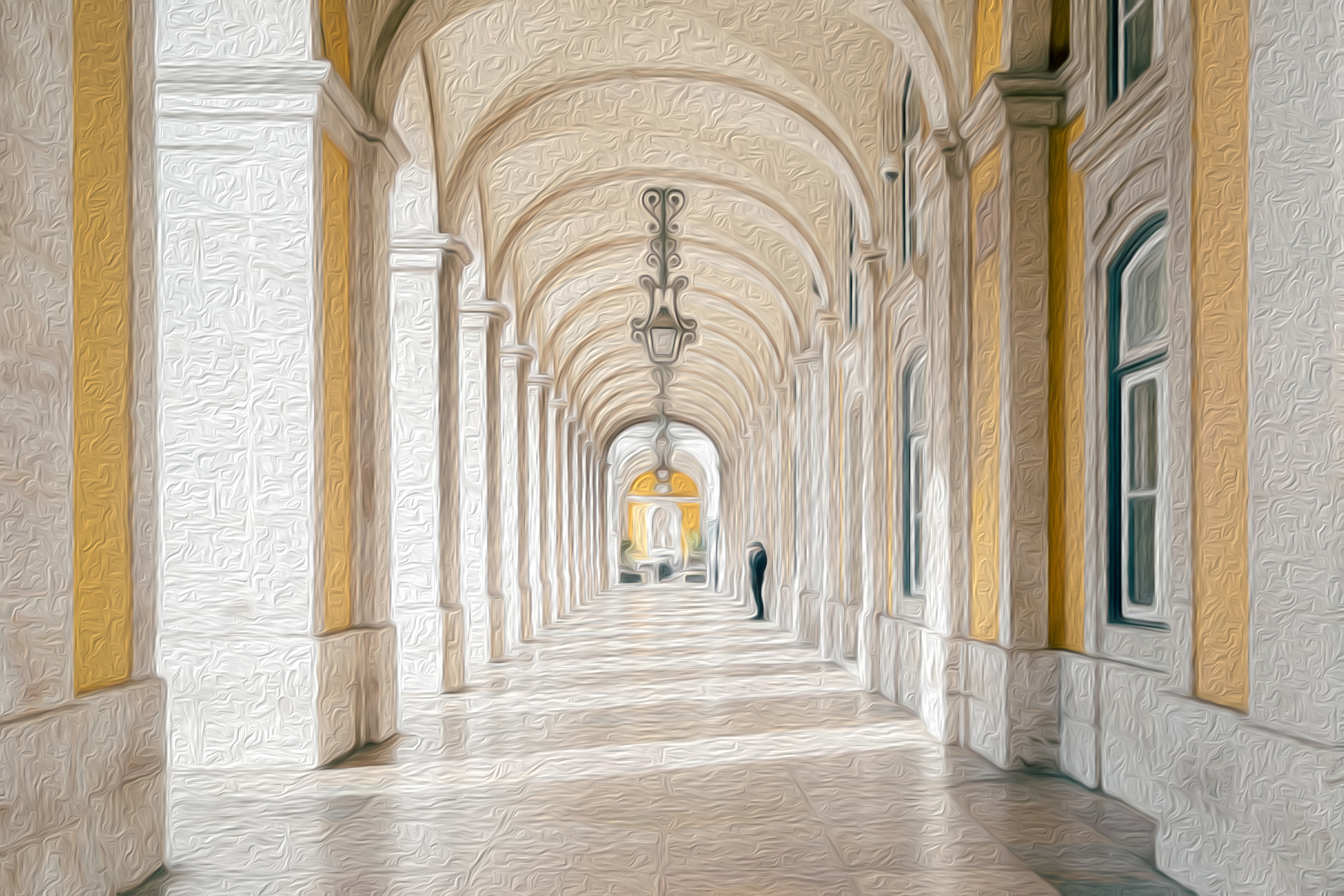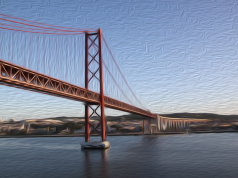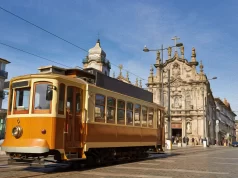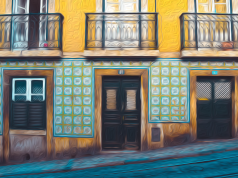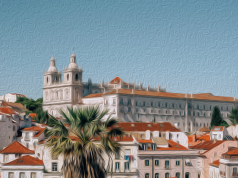Portugal was ruled by a monarchy for around 800 years, and Lisbon housed many kings and queens during that period. Over the centuries, many Portuguese royal family palaces were built in the country. Palaces built at that time indicated the power and wealth of the ruling families. For this reason, they were built intricately and also used as royal residences. There are also important castles built centuries ago to protect the country against attacks.
Lisbon’s royal history dates back to the 12th century with the establishment of the Kingdom of Portugal. Throughout the centuries, Portugal monarchy saw periods of growth and decline, with several significant events. The assassination of King Carlos I in 1908 and the establishment of the Portuguese Republic in 1910 are among them. Despite the overthrow of the monarchy, Lisbon’s palaces and castles remain a testament to the city’s rich history and cultural heritage.
In this article, you’ll find a detailed guide about these Portugal castles and palaces.
Lisbon Palaces

There are several royal residences and national palaces in Lisbon, and many of them are open to the public. While you’re visiting these buildings, you’ll witness the history of the country. Even the walls tell lots of stories about it.
Let’s look at some of the most popular palaces in Lisbon.
Palace of Belem
The Palace of Belem was built in the 16th century, and it’s also the presidential office and official residence. In the 19th century, it was renovated and served as the official presidential residence after 1951. Some people even consider it the most beautiful palace in the world.
In Belem palace, there’s a museum that is dedicated to all presidents of the Republic of Portugal. One of the outstanding features of this beautiful palace is that there are lion cages of Queen Maria I. It’s located in the entrance courtyard. Other highlights of the palace include the Sala Dourada, the gilded ceilings made of wood, and the Great Garden.
To visit the palace, you can book a tour on Saturdays. You can also visit the Presidency Museum, it’s open every day but Monday.
The palace is very close to the Belem train station. Possible transportation options to use are train, tram, bus, metro, and funicular.
Address: Praça Afonso de Albuquerque, 1300-004 Lisboa, Portugal
Queluz National Palace
The Queluz National Palace, located in Queluz, Portugal, is a stunning 18th-century palace. It’s known for its beautiful rococo architecture and ornate interiors. The palace was a summer palace for King Pedro III and Queen Maria I. It served as a royal palace until the fall of the monarchy in 1910.
The Portugal palace features a mix of Portuguese, French, and Italian styles, with notable features such as the Grand Staircase, the Throne Room, and the Dining Room. Its garden is also gorgeous with fountains and mythological statues.
Today, the Queluz National Palace is a museum open to the public and is considered one of the most important examples of Portuguese Baroque architecture. You can even eat food at the restaurant which was once the kitchen of the palace.
Address: Largo Palácio de Queluz, 2745-191 Queluz, Portugal
Ajuda National Palace
The Ajuda National Palace is a 19th-century neoclassical palace located in Lisbon, Portugal. It was built to replace the ruined Palace of the Ribeira, which was destroyed in the 1755 earthquake.
The Ajuda Palace served as the residence of the Portuguese monarchy until the establishment of the Republic in 1910. The palace features a mix of classical and romantic styles.
Today, the Ajuda National Palace is open to the public. It is considered one of the most important examples of Portuguese neoclassical architecture and is a notable landmark in Lisbon. The interiors are designed in the Baroque style. Being a museum now, the palace showcases some decorative arts and collections. Some of them even date back to the 15th century.
Address: Largo da Ajuda, 1349-021 Lisboa, Portugal
Pena Palace
Pena Palace is a 19th-century palace located in Sintra, Portugal, near Lisbon. It is considered one of the greatest expressions of Romantic architecture in the world. It’s characterized by its vibrant colors, whimsical towers, and ornate details. Many people consider it like the place of fairy tales.
The Portuguese palace was built on the site of a former 16th-century monastery and served as a summer residence for the Portuguese royal family. In the 20th century, it was transformed into a museum, showcasing its grand halls, courtyards, and panoramic views of the surrounding landscape. The palace is surrounded by a forest, which contributes to its Romantic architectural tones. In this forest, there are more than 500 tree species as well.
Today, Pena Palace is a popular tourist attraction attracting visitors from all over the world. You can tour the palace and the surrounding area.
Address: Estrada da Pena, 2710-609 Sintra, Portugal
National Palace of Sintra
The National Palace of Sintra is located in the town of Sintra, near Lisbon, Portugal. It is one of the most important examples of Portuguese Gothic and Manueline-style architecture and is a popular tourist destination. Also, this Lisbon palace is one of the oldest palaces in Portugal.
The palace was built in the 9th century as a residence for Moorish governors. Then it served as the royal residence of King John I, one of the kings of Portugal. It was a royal palace for the Portuguese monarchy from the 15th to 19th centuries. Now, it’s open to the public as a museum. You can recognize the palace with its huge conical chimneys. The ceilings, rooms, and tile panels are the highlights of this palace.
Address: Largo Rainha Dona Amélia, 2710-616 Sintra, Portugal
Castles in Lisbon
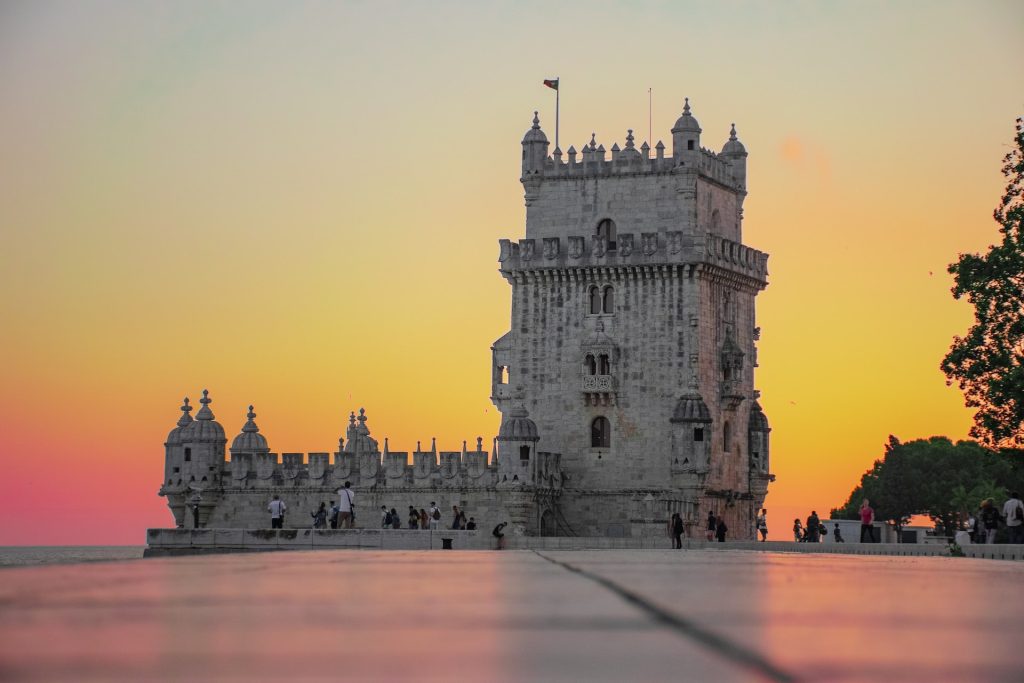
Lisbon has several historic castles that are popular tourist attractions. They offer a glimpse into Lisbon’s rich history and provide an opportunity to admire the city’s stunning views.
Find some of the most popular castles in Lisbon below.
Sao Jorge Castle (St. George’s Castle)
This Lisbon castle is located on a hill in the historic center of Lisbon and offers panoramic views of the city. You can enjoy the views from its walls and terrace. It was initially built by the Moors in the 11th century and later reconquered by Christians in the 12th century. This Portugal castle was greatly affected by the 1755 earthquake and was restored later. It was named after St. George in 1373 after the Anglo-Portuguese Treaty.
The castle has 10 towers, and it’s open from 10 a.m. to five p.m. You can take the bus 737 or trams 28 and 12 to go to this castle.
Address: R. de Santa Cruz do Castelo, 1100-129 Lisboa, Portugal
Belém Tower
The Belem Tower (Torre de Belem) is one of the most popular Portuguese castles in Lisbon. It was built in the early 16th century as a defensive fortification. Also, it was a symbol of Portugal’s maritime power during the Age of Discovery. It’s located on the bank of the Tagus River and is considered one of Lisbon’s most iconic landmarks.
The tower features a mix of Gothic and Manueline architectural styles, with intricately carved stone details and maritime motifs. Inside, there is a small chapel dedicated to Our Lady of Safe Homecoming. In addition, there’s a museum showcasing the tower’s history and significance. This castle in Portugal attracts visitors from around the world to admire its unique architecture and stunning location. It is also a UNESCO World Heritage Site, recognized for its cultural and historical significance.
Address: Av. Brasília, 1400-038 Lisboa, Portugal
Castle of Evoramonte
The Castle of Evoramonte is a medieval castle located in the town of Evoramonte, in the Estremoz region of Portugal. This castle Lisbon was built in the 14th century and has been the site of several historic events. These include the signing of the Treaty of Evoramonte in 1834, which ended the Portuguese Civil War.
Today, the castle is a popular tourist attraction and offers a glimpse into Portugal’s rich history and cultural heritage. Visitors can explore the castle’s grounds and learn about its history through guided tours and exhibitions.
You can reach the castle on roadways A2 and A6 fast way.
Address: R. da Convenção 6, 7100-314, Portugal
Obidos Castle
This castle Lisbon Portugal dates back to the 12th century and was used for military and defensive purposes throughout its history. It’s surrounded by the town’s well-preserved medieval walls. It was a wedding gift by King D. Dinis to Queen Santa Isabel during their wedding.
Sitting upon a hill, the castle offers stunning views of the surrounding countryside. It’s also considered a great example of medieval architecture. It includes elements of Gothic, Baroque, and Manueline. Today, it houses a hotel, offering visitors an authentic experience. It’s located an hour away from Lisbon.
Address: R. Josefa de Óbidos, 2510-001 Óbidos, Portugal
The Castle of Almourol
This is one of the Lisbon castles that date back to the medieval period. The castle dates back to the 12th century and was built by the Knights Templar. It served to divide the Christian and Moorish sections of Portugal as well. It was damaged heavily in the 1755 earthquake but restored later.
Located on an island in the Tagus River in Ribatejo, it’s approximately an hour and a half city north of Lisboa. Visitors can explore the castle’s grounds and enjoy the views of the surrounding area.
Address: Praia do Ribatejo, Portugal
Conclusion
In short, the beautiful palaces and castles in Portugal offer something about the rich history of this country. You can pay a visit to some of them on your next trip to Lisbon.
FAQ
What is the most famous palace in Lisbon?
The most famous palace in Lisbon is the Palace of Queluz, also known as the National Palace of Queluz.
How many castles are there in Lisbon?
Lisbon has several castles, including the Castle of Sao Jorge, the Castelo de São Vicente, and the Castle of Almourol.
Can you visit the castles and palaces in Lisbon?
Yes, most of the castles and palaces in Lisbon are open to the public for tours and visits.
What is the history behind the Palace of Queluz?
The Palace of Queluz was built in the late 18th century as a summer residence for King Pedro III and his wife, Queen Maria I. It is known for its rococo and neoclassical architecture and intricate interiors.
What is the best time to visit the castles and palaces in Lisbon?
The best time to visit the castles and palaces in Lisbon is from April to October, when the weather is warmer and there is less chance of rain.

